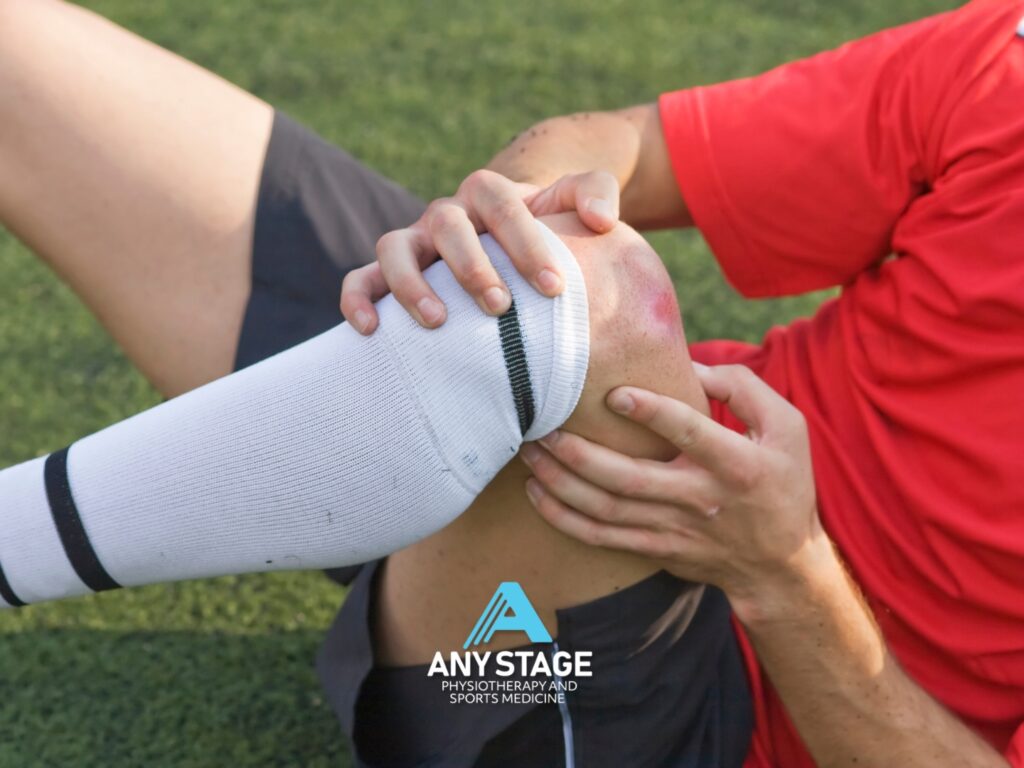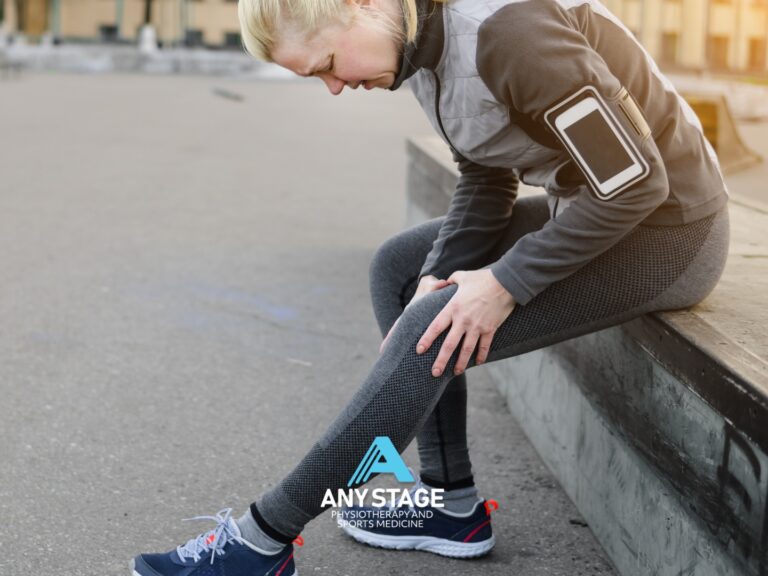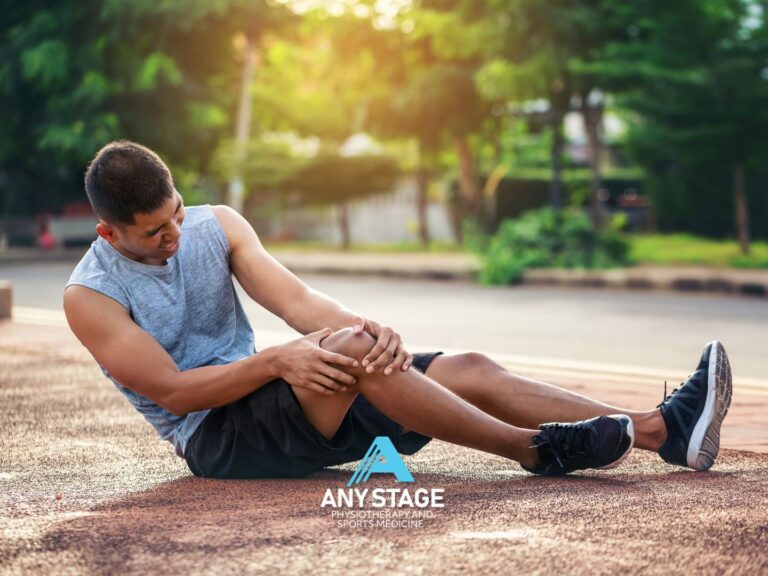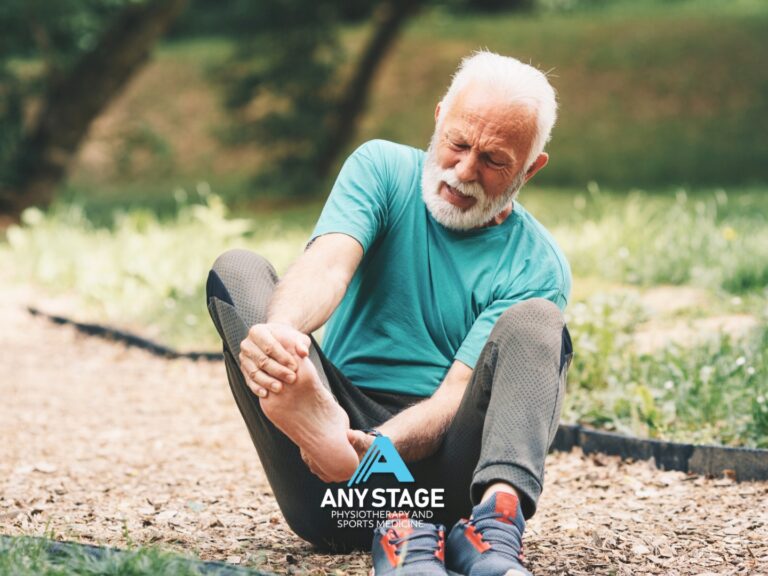What is ACL Injury?
An injury to the anterior cruciate ligament (ACL) is very common in the sporting community, particularly with sports that involve changing directions quickly (cutting) or contact/tackles. Whether managed surgically or not, the road to recovery and returning to sport requires a structured and progressively monitored journey. Fortunately, research around ACL rehabilitation is continually evolving, supporting and guiding the treatment being implemented by our physiotherapists and Any Stage Physiotherapy and Sports Medicine.
What is ACL?
The anterior cruciate ligament (ACL) is one of the four main ligaments that provide stability to the knee joint. It is a thick band of tissue that connects the femur (thigh bone) to the tibia (shin bone) and helps to control the anterior (forward) translation of the tibia on the femur. The ACL also helps to provide stability and control through rotational movements of the knee. The ACL is located in the centre of the knee joint and runs diagonally, crossing over the posterior cruciate ligament to form an “X” shape.


Common ACL Injuries
The ACL is critical for knee function, providing stability and proprioceptive information, particularly in high impact activities. The ACL can be injured in a variety of ways, but the most common mechanism of injury is a sudden twisting or hyperextension of the knee joint. Here are some of the ways that the ACL can be injured:




ACL injuries can range from a minor sprain to a complete tear, and can result in significant pain, swelling, instability, and difficulty weight bearing on the affected leg. Treatment for an ACL injury depends on the severity of the injury. Following an ACL injury, most recent research indicates the importance of regaining strength and range of motion, which may continue along a conservatively managed treatment plan. If surgery is indicated, the stronger the supporting structures of the knee can become and regaining knee flexion and extension prior to surgery, provides the most optimal outcome during post-operative rehabilitation. with physiotherapy guidance.
Risk factors for ACL injuries include participation in sports that involve jumping, cutting, and pivoting, as well as factors such as muscle weakness, poor conditioning, and improper landing technique. Prevention strategies such as proper conditioning, strengthening exercises, and implementing strong and stable landing techniques can help reduce the risk of ACL injuries.
Common symptoms of an ACL injury
The symptoms of an anterior cruciate ligament (ACL) injury can vary depending on the severity of the injury. Here are several common symptoms of an ACL injury:
- Pain: sudden pain that can range from mild to severe.
- Swelling: within the first few hours and can continue to swell for several days.
- Reduced movement: inability to straighten or bend the knee.
- Instability: the knee may feel unstable and give way when putting weight through it.
- Popping sound or sensation: at the time of injury, a popping sound or sensation may be heard or felt.
- Difficulty walking: a limp due to pain, instability, reduced range of movement and/or swelling.
Treatment options for ACL Injury
Surgery is often recommended for people with an ACL injury if they have a complete tear, if they are young and active, or if they have a physically demanding job. Surgery may also be recommended for athletes who complete in a sport where demands include physical contact and change of direction, particularly if the ACL injury is associated with other injuries, such as a meniscus tear or damage to other ligaments in the knee.
The main reasons that surgery may be recommended to repair the ACL include:
- To restore knee stability:
The ACL is an important ligament that helps to stabilise the knee joint. When the ACL is torn, the knee can become unstable and feel like it’s giving way. Surgery can help to restore knee stability and reduce the risk of further knee injuries. - To prevent long-term complications:
An untreated ACL injury can lead to long-term complications such as chronic knee pain and instability. Surgery can help to prevent these complications by restoring optimal knee function and reducing the risk of further injuries. - To improve quality of life:
ACL injuries can be debilitating and can limit a person’s ability to participate in activities they enjoy. Surgery can help to restore knee function and improve quality of life by allowing people to return to their normal activities.
There are several graft options that can be used in ACL reconstruction surgery to replace the torn ligament. Here are the most common types of grafts and their characteristics:
- Autografts
An autograft is a graft that is taken from the patient’s own body. The most common types of autografts used in ACL repair are the patellar tendon graft and the hamstring tendon graft. The patellar tendon graft is taken from the patient’s own patellar tendon, which connects the kneecap to the tibia bone. The hamstring tendon graft is taken from the patient’s own hamstring muscles, which run along the back of the thigh, this often includes the tendons from the semitendinosus and gracilis muscles. - Allografts
An allograft is a graft that is taken from a donor’s body. Allografts are commonly used in ACL repair when the patient’s own tissue is not suitable for grafting. The most common types of allografts used in ACL repair are the Achilles tendon and the anterior tibialis tendon. - Synthetic grafts
Synthetic grafts are grafts that are made from synthetic materials, such as polyester or carbon fibre. Synthetic grafts are not commonly used in ACL repair because they do not have the same mechanical properties as natural tissue grafts.
The type of graft used in ACL repair can affect the outcomes of the surgery, including the risk of re-injury, the time it takes to return to sports or activities, and the long-term function of the knee. Your orthopaedic specialist will discuss these options with you.
A Roadmap for Returning to Sport After ACL Reconstruction
Returning to sport following an anterior cruciate ligament (ACL) reconstruction is a gradual process that involves several components. ACL rehabilitation uses knowledge of tissue healing time and individualised tolerance to treatment, which helps guide treatment progressions. Everyone experiences post-operative treatment differently and cannot be compared to each other. Specific stages of treatment are expected to be met, which are briefly outlined below, before progressions can be introduced by your physiotherapist. A return to sport guideline following ACL surgery is progressively introduced over at least a 12-month time frame:
Early Rehabilitation
The first component of returning to sport following an ACL reconstruction is early rehabilitation. This usually starts within the first few days of the surgery and includes:
- Swelling management
- Range of motion exercises
- Muscle activation exercises
- Pain management
Functional Rehabilitation and Strengthening
Once the early rehabilitation phase is achieved, functional rehabilitation and progressive strengthening is introduced. This phase focuses on improving neuromuscular control, agility, balance, coordination and functional strength to muscle groups throughout the leg. Exercises may include plyometrics, sport-specific drills, and balance training. This phase forms the majority of the post-operative treatment process.
Return-to-Play Testing
Before returning to running and sport, the patient must undergo return-to-play testing to ensure that they have regained strength, stability, and range of motion in the affected knee. Testing may include a variety of physical tests, such as a variety of hop tests, strength testing, and agility drills.
Gradual Return to Sport
The final component of returning to sport following an ACL reconstruction is a gradual return to sport. The athlete should start with low-intensity activities and gradually progress to higher-intensity activities over time. There are three phases within this stage of rehabilitation in order that the player returns to sport successfully. The return to sport continuum includes:


Phase 1 – Return to participation:
Able to participate in activity (rehabilitation exercises or training), which includes running at a lower level than what is necessary to return to sport. Not yet ready medically, physically or psychologically to return to sport.
Phase 2 – Return to sport:
Returned to defined sport skills, including change of direction running, jumping and un-anticipated movement, however, not yet performing at the desired level.
Phase 3 – Return to performance:
Returned to sport and is performing at or above pre-injury level.
Final thoughts on returning to sport after an ACL injury
It is important to note that returning to sport following an ACL reconstruction is not a one-size-fits-all process. The timeline and specific components of the rehabilitation process may vary depending on the individual’s specific situation, including the extent of the injury, the type of surgery, and the athlete’s goals and sport requirements. It is important to work closely with your medical team (orthopaedic specialist, physiotherapist and doctor) to develop an individualised rehabilitation plan that is tailored to your needs and goals.
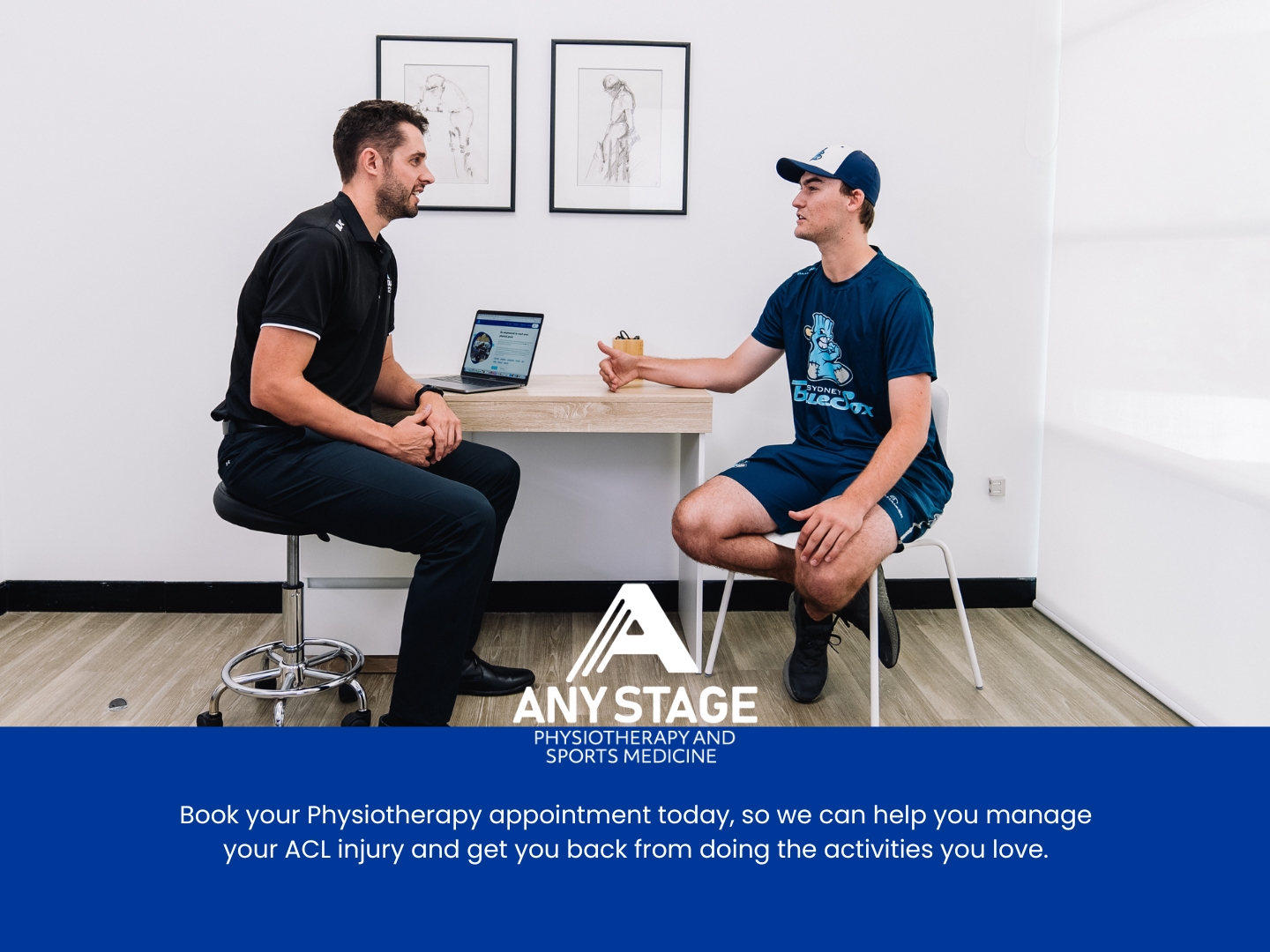

The information provided above is general in nature. If you have experienced a recent ACL, or, you have persistent knee pain, please do hesitate to contact our friendly and experienced team at Any Stage Physiotherapy and Sports Medicine for individualised assessment and information. We are here to guide you back to a pain free lifestyle and help return you to sport.
Authors


Daniel Lee
DPT, B. Sc, APAM
Director / Principal Physiotherapist
Daniel Lee has created a specialised approach to Physiotherapy treatment, return to sport and injury prevention by incorporating a functional strength & conditioning approach, no matter the individual’s age, sport, lifestyle, or competition level.

Shannon Murray
DPT, B. HSc, APAM
Physiotherapist
Shannon completed her Doctor of Physiotherapy degree at Macquarie University, after relocating from Queensland, where she completed her Bachelor of Health Science degree. Whilst completing her Doctor of Physiotherapy degree, she gained valuable experience in various setting, including private practice and hospital.


